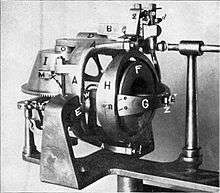Whitehead Mark 3 torpedo
| Whitehead Mark 3 torpedo | |
|---|---|
|
Mark 3 Whitehead torpedo fired from East Dock, Goat Island, Newport Torpedo Station, Rhode Island, 1894 | |
| Type | Anti-surface ship torpedo[1] |
| Place of origin |
|
| Service history | |
| In service | 1898–1922[1] |
| Used by |
|
| Production history | |
| Designer | Robert Whitehead |
| Designed | 1893[1] |
| Manufacturer |
Torpedofabrik Whitehead & Co.[3] E. W. Bliss Company |
| Specifications | |
| Weight | 845 pounds[1] |
| Length | 140 inches (3.55 meters)[1] |
| Diameter | 17.7 inches (45 centimeters)[1] |
|
| |
| Effective firing range | 800 yards[1] |
| Warhead | wet guncotton[1] |
| Warhead weight | 118 pounds[1] |
Detonation mechanism | War Nose Mk 1 contact exploder[1] |
|
| |
| Engine | 3-cylinder[1] |
| Speed | 26.5 knots[1] |
Guidance system | gyroscope[1] |
Launch platform | battleships and torpedo boats |
The Whitehead Mark 3 torpedo was a Whitehead torpedo adopted by the United States Navy for use in an anti-surface ship role after the E. W. Bliss Company of Brooklyn, New York secured manufacturing rights in 1892.[2]
The primary difference between the Mark 3 and the previous versions of the 3.55-meter Whiteheads was the inclusion of the Obry steering gyro for azimuth control. This device reduced the maximum deviation right or left of the target from 24 to 8 yards.[4] About 100 Mark 3s were purchased from the E. W. Bliss Company; in 1913, these were redesignated Torpedo Type A.[5] These were withdrawn from service use in 1922 when all torpedoes designed before the Bliss-Leavitt Mark 7 torpedo were condemned.[1]
Characteristics

The Mark 3 was ordinarily assembled into three sections: the warhead, the air flask and the after-body. The warhead's charge of wet guncotton weighed 118 pounds. The Mark 3 was what was known as a "cold-running" torpedo.[1] The three-cylinder engine ran on cold, compressed air which was stored in the air flask. The after-body carried the engine and the tail, which contained the propellers.[6]
The Mark 3 was launched from battleships and torpedo boats.
References
- ↑ "Chronology: Torpedo in Word and Picture". Retrieved 2013-06-08.
- ↑ "United States of America Torpedoes Pre-World War II". Retrieved 24 June 2013.
- ↑ Silverstone, Paul (2006). The New Navy, 1883-1922. Taylor & Francis Group. pp. xxiii. ISBN 0-415-97871-8.
- ↑ The Whitehead Torpedo:. Bureau of Ordnance, United States Navy. 1898.
